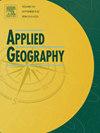对俄亥俄州安全上学路线旅行计划中地图绘制作用的关键评估
IF 5.4
2区 地球科学
Q1 GEOGRAPHY
引用次数: 0
摘要
安全上学路线是一项耗资10亿美元的美国政府项目,该项目为基础设施建设提供资金,使步行和骑自行车上学更加安全。俄亥俄州运输部(ODOT)选择使用GIS资助的项目。这些地图显示了过去五年里,学生们住的地方与学校的关系,以及附近发生过行人和自行车事故的地方。在本文中,我仔细研究了该分析中使用的数据及其使用方式,并询问更详细的、文献信息丰富的GIS分析是否可以改进用于选择最具影响力的社区项目的指标。为了回答这个问题,我分析了在肯特(俄亥俄州)城市学区创建学校旅行计划的定量标准的应用,以及解释如何使用这些数据来做出资金决策的指导方针。然后,我创建了新的地图,使用类似的数据,但通过遵循识别步行性和交通问题的最佳实践,改变了方法。我的分析表明,与俄亥俄州SRTS项目中使用的当前制图方法创建的地图相比,更细致的GIS分析可以更好地识别最具影响力的项目。本文章由计算机程序翻译,如有差异,请以英文原文为准。
A critical assessment of the role of mapping in Ohio Safe Routes to School travel plans
Safe Routes to School is a billion-dollar U.S. government program that funds infrastructure to make walking and biking to school safer. The Ohio Department of Transportation (ODOT) selects projects to fund using GIS. These maps show where students live in relationship to the school and where pedestrian and bicycle crashes occurred nearby in the past five years. In this paper, I take a closer look at what data is used -- and how it is used -- in this analysis and ask if a more detailed, literature-informed GIS analysis could improve the metrics used to select the most impactful neighborhood projects. To answer this question, I analyzed the application of quantitative criteria to create a school travel plan in Kent (Ohio) City School District as well as the guidelines that explain how these data are used to make funding decisions. I then created new maps that use similar data but change the methodology by following best practices for identifying walkability and traffic issues. My analysis indicates that a more nuanced GIS analysis can identify the most impactful projects better than the maps created by the current mapping approach used in the Ohio SRTS program.
求助全文
通过发布文献求助,成功后即可免费获取论文全文。
去求助
来源期刊

Applied Geography
GEOGRAPHY-
CiteScore
8.00
自引率
2.00%
发文量
134
期刊介绍:
Applied Geography is a journal devoted to the publication of research which utilizes geographic approaches (human, physical, nature-society and GIScience) to resolve human problems that have a spatial dimension. These problems may be related to the assessment, management and allocation of the world physical and/or human resources. The underlying rationale of the journal is that only through a clear understanding of the relevant societal, physical, and coupled natural-humans systems can we resolve such problems. Papers are invited on any theme involving the application of geographical theory and methodology in the resolution of human problems.
 求助内容:
求助内容: 应助结果提醒方式:
应助结果提醒方式:


